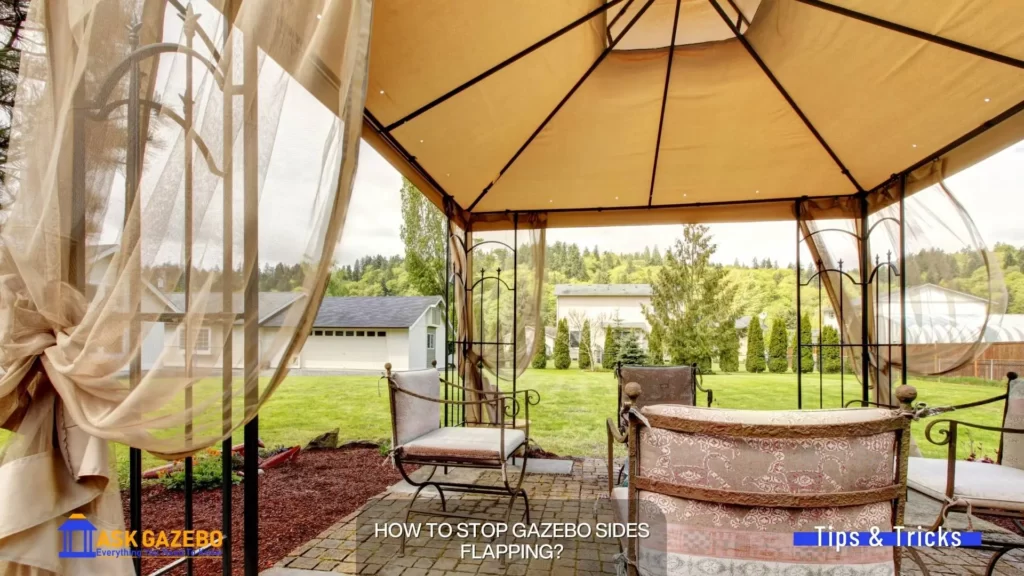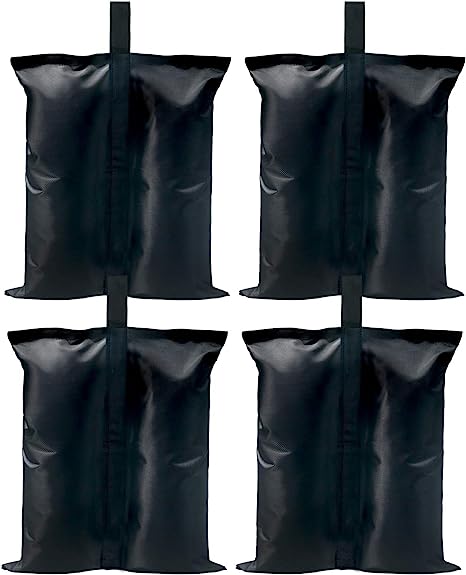Gazebos are the shaded spots in gardens that provide shelter and protection against wind, sun, and rain.
However, when the wind picks up, their sides can turn into restless flappers, producing irritable sounds and causing frustration.
It is a common problem that many gazebo owners face. But since every problem has a solution, we have brought you some proven solutions to keep your gazebo’s sides tightly in place.
In this article, we have explained effective ways to prevent gazebo sides from flapping.
But before we delve into the main topic, let’s take a quick look at why this happens in the first place.
Understanding the causes
- Natural elements: Gazebos have an open structure that makes them prone to wind’s force. When the wind blows, it produces a lifting effect, making gazebo sides flap uncontrollably.
- Using poor quality gazebo: The make-up of a gazebo and the materials it’s made from play a big role in its functionality. Low-quality side materials tend to flap more and can also tear apart easily.
- Installing gazebo on uneven surfaces: When you set up a gazebo on bumpy ground, you disturb its overall stability. This lack of steadiness can cause it to wobble when wind flows, leading to unwanted movement of sides.
- Securing gazebo sides improperly: If you don’t properly secure the sides of a gazebo, they can flap due to even a slight breeze. Not only this, but they can also put stress on the frame and cause potential damage in the long run.
Why is it important to keep gazebo sides stable?
Stabilizing gazebo sides is crucial for multiple reasons, such as:
- It helps prevent unwanted accidents.
- It lets you make the most of your gazebo without being held back by elements like wind or rain.
- They support your decoration items.
- Stable sides have a longer lifespan.
- They help create a comfortable environment free of pesky bugs.


Effective Ways to Stop Gazebo Sides Flapping
You can stop the gazebo sides from flapping by installing your gazebo in the right location, picking up a robust frame, correctly assembling your gazebo, adding weights, using windbreaks, reinforcing the gazebo frame, and securing the gazebo sides.
Regular check and balance is also crucial for using a gazebo safely.
Let’s discuss these points further.
Choose the right location:
Gazebo sides are more prone to flapping when placed in open, exposed locations. Therefore, consider securing your gazebo in a sheltered spot, such as near walls or trees. Ensure no sharp obstacles are nearby, as they can rip the side material during strong winds.
You should carefully choose a suitable ground surface. Concrete is a more stable and durable option than grass, but the latter provides more options for securing your gazebo.
Pick a robust gazebo frame:
How well your gazebo resists strong wind forces depends on many factors, including its frame design, construction, and material.
Metal frames are long-lasting and durable compared to flimsy frames crafted from plastic or thin aluminum. They are a better option for areas prone to strong winds.
Look for a frame with reinforced joints, thick frame tubing, and reliable roof cover.
Install gazebo the right way:
Proper gazebo installation ensures the stability of your gazebo as well as its components. Different gazebo models come with distinct installation requirements, so it’s crucial to carefully follow the manufacturer’s instructions to set them up correctly.
Alternatively, you can hire a professional gazebo builder.
Secure the gazebo sides:
One of the simplest ways to prevent gazebo sides from flapping is by securing them properly. Ensure these sides are securely attached to the frame. Most gazebo sides are attached via a built-in technique like zipping, Velcro straps, or hooks.
Tighten these fastening elements so they can resist wind pressure. You can provide them with additional support using zip ties, clips, and clamps.
Gazebo weights and sturdy anchors:
You can prevent your gazebo from moving around during windy conditions by using weights and anchors.
Gazebo weights are available in the market in different forms, such as water weights, sandbags, cast-iron weights, concrete blocks, or bricks. Water and sandbags are portable options, as you can empty or refill them as needed.


This kit provides ample weight to keep your gazebo securely anchored even in the high winds. The sandbags are also easy to fill and empty. We highly recommend this anchoring kit for almost every type of gazebo.
View On
Use windbreaks:
Windbreaks form a shielded buffer zone around gazebos and do not let wind reach gazebos with full force. You can create a natural windbreak using trees or vegetation or position a physical windbreak like a fence, mesh fabric, solid panel, or privacy screen around it.
Properly positioning windbreaks is crucial for their effectiveness, as they can create turbulence if not placed in the right direction.
Reinforce gazebo frame
Strengthening your gazebo frame can also help prevent flapping sides. You can add extra bracing to weak points for this purpose.
If it does not work, it may be the right time to upgrade your lightweight gazebo frame to a heavier material like steel. A sturdy frame is less likely to let the sides flap.
Regular checkups
Regularly checking your gazebo’s condition will allow you to take preventive measures on time and avoid costly damage.
During these routine checkups, you should look for damaged sides, loose connections, or signs of wear and tear. Repair the damaged area on time so its condition does not worsen due to negligence.
If possible, dismantle and store your gazebo during severe weather conditions to increase its lifespan and protect sides from strong winds.


Subscribe For More Gazebo Videos!
Ask Gazebo
How To Keep Gazebo Curtains From Blowing?
You can stop gazebo curtains from blowing by choosing the suitable curtain material, using proper attachments, adding curtain weights, and installing windbreak panels.
Let’s discuss these DIY tips further.


Choose the right curtain material:
Lightweight curtain materials have an appealing aesthetic, but they don’t stand up as well to wind pressure compared to their heavyweight counterparts.
Therefore, opt for thicker and heavier materials such as Sunbrella fabric, outdoor canvas, marine-grade vinyl, and polyester blends. These not only withstand wind effectively but also provide enhanced protection and privacy.
Use proper attachment techniques:
Secure curtains to the gazebo frame using suitable weather-resistant fasteners, such as clips, ties, Velcro, and hooks.
Ensure they are firmly attached to both the curtains and the frame; otherwise, they won’t effectively prevent curtains from blowing freely in the wind.
You can further tie the curtains with the gazebo frame or legs for a better grip.
Add curtain weights:
Make your curtains heavier by adding weights at the bottom of their panels. This simple addition will significantly diminish the likelihood of them being blown around during windy conditions. Washers, marbles, fishing weights, and stones are a few handy weights you can use for this purpose.
You can also attach some heavy decorative items to your curtain’s hem. This not only increases the aesthetics of your gazebo but also ensures the sides stay firmly in position.


You can sew this chain at the bottom of your outdoor curtains to weigh down your outdoor curtains. It will work as a DIY curtain weight and make your gazebo curtains windproof curtains.
View On
Install windbreak panels:
They will create a barrier around curtains, reducing the force of wind. If you are concerned about these panels blocking your view, you should opt for clear PVC panels that provide protection while still allowing you to enjoy the scenery.
Tie with heavy furniture:
To prevent your gazebo curtains from blowing around in the wind, you can tie them to your outdoor furniture. Position your furniture at the edge of the gazebo so that the curtains can easily reach and be fastened securely.
Maintain your curtain:
Well-maintained curtains perform more efficiently, so it’s essential to regularly clean and inspect them to keep them in good shape. Regular inspections also enable you to tighten any loose curtain parts or mend any damage, reducing the risk of accidents.
Learn Next: How To Keep Birds From Nesting in Gazebo
FAQs
How do you stop Gazebo sides from Flapping?
To prevent gazebo sides from flapping, choose a sturdy frame, assemble it correctly, add weights, use windbreaks, reinforce the frame, and secure the sides firmly.
How to keep outdoor curtains from sliding on rod?
To stop your outdoor curtains from sliding on the rod, attach magnets on the rod and weights at the bottom of the curtains. It will keep your gazebo curtains in place even in windy weather.
How do you Weigh down a Gazebo side?
Adding sandbags with gazebo legs is the easiest way to weigh down the gazebo sides. You can also use bungee ropes to tie down the gazebo sides with concrete.
Can you leave a gazebo in the wind?
You can leave a permanent gazebo that is well anchored with ground in the windstorm. But, if you have a pop-up or temporary gazebo, it is better to disassemble the gazebo and place it in a secured place before any wind storm.
How do I stop my gazebo roof from flapping in the wind?
To prevent your gazebo roof from flapping, securely tie it to the frame, screw it in, and add weights on top of the gazebo roof.
Conclusion
Stopping your gazebo sides from flapping does not have to be a challenging task.
If you follow these simple techniques, like selecting a suitable location, tightly fastening the gazebo sides, and using weights, you can enjoy your gazebo’s comfort and protection even during windy days. Don’t forget to opt for a sturdy gazebo frame if you live in a wind-prone area.
Additionally, these practical and effective tips will also make your gazebo last longer, giving you more opportunities to enjoy your time outdoors.







